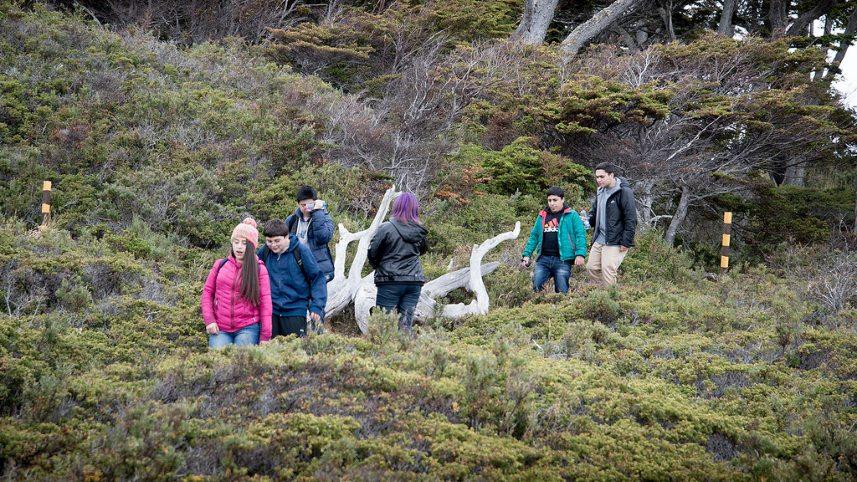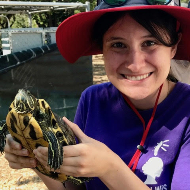Place-based learning, outreach, and climate change education

How is volunteering at a food pantry related to environmental issues? I had this thought, or something similar, as I read proposal after proposal for what my Master’s advisor called a “service learning” project he had undergraduates conduct during their “People and the Environment” class. I eventually had to ask: what are you teaching these students in this class? What I did not understand then is that People and the Environment was a place-based course. The projects were meant to get the students involved in the community to further cement the concepts learned in class; concepts of how humans relate to their environment and depend on it for food, shelter, and community. So yes, volunteering at a food pantry can illustrate the concepts, on a local scale, of income inequality and economic injustice. Observing a robin’s nest to learn about natural selection and evolution, planting a backyard food garden to learn about nutrient cycling, or volunteering one’s time at the local homeless shelter can all illustrate broad concepts on a community scale—a central idea behind the theory of place-based learning.
Although the concepts central to place-based learning have been used by educators for some time, the formal term “place-based learning” was first coined in the early 1990s by Laurie Lane-Zucker of the Orion Society, a Massachusetts-based environmental nonprofit, and David Sobel, Project Director at Antioch University, New England. The primary goal of place-based learning that makes it different from other educational philosophies is the emphasis on community, including human, plant, and animal neighbors. The local community is viewed as a primary source of knowledge—a place to observe various ecosystem processes, human-nature relationships, city planning, and aspects of human culture and society. Proponents of place-based learning believe that focusing on continental or global issues too quickly in a child’s education causes them to lose a sense of how one fits into the complex fabric of life. In order for students to truly understand how their morning bowl of oatmeal affects the polar ice caps, they first have to understand what it takes to grow food in their backyard garden.
Place-based learning, it turns out, can be an excellent framework to teach the science of climate change. Climate change is a huge, complex issue intertwined in almost every aspect of the human existence; it is easy to see why many adults, let alone grade-school or even high school students, are overwhelmed trying to understand the science. Place-based learning can take a complicated issue and break it down into easily teachable parts that are immediately relevant because the primary sources of information are the plants, animals, and people that students interact with daily. For example, the concept of global carbon cycles is daunting at best. But it can be understood in terms of watching local plants grow and die; in measuring the biomass produced by a tree in a single growing season; in watching an earthworm colony turn a pile of leaves into soil. After observing those phenomena, students are ready for scaled-up questions: What's true when individual trees are part of a forest? Where does their stored carbon go when humans cut them down?
Some places have implemented this approach to great success. In 2000, James Lewicki implemented a place-based learning program at a small charter high school in Wisconsin. Students engaged in a variety of projects related to the local community of Kickapoo Valley, fincludeing researching Civil War veterans that made their homestead there, building benches for community parks, and monitoring changes to a 250-acre wetland restoration project. The students bonded with each other and their community, which was their place of learning. Their experiences, in nature and in local libraries and museums, imparted skills that are difficult to replicate in a classroom setting. Overall the students scored almost three grade levels higher on their standardized tests, especially in evaluating and analyzing information, identifying and analyzing sources of information, and organizing their thoughts and ideas.
Devoting an entire year to place-based learning is out of the question for most schools, but even a small amount of exposure can improve learning outcomes and community bonding. In Iowa City, where I am a graduate student, we have a place-based environmental education non-profit called Taproot. Its focus is on unstructured play in outdoor settings with learning opportunities spontaneously presented based on the children’s interests. I know a few parents who have their children enrolled in the Taproot afterschool programs. Although they do not discuss their children's environmental education much, they have expressed that their children are learning better interpersonal skills and the ability to cooperate during play. Place-based learning reinforces community bonds—this is often reported as a secondary goal of place-based learning, but in a world of increasing isolation, due to the prevalence of technology and its strong pull to remain indoors, the goal of strengthening community bonds should not be overlooked.
The benefits of place-based education for formal student learning may seem obvious at this point. But what happens when place-based educational ideas are implemented in a setting that caters to adults? Sarah Schweizer, Shawn Davis, and Dr. Jessica Thompson set out to understand how place-based climate education might not only provide information about climate change but also change values and beliefs related climate change. In their article “Changing the Conversation about Climate Change: A Theoretical Framework for Place-Based Climate Change Engagement” published in Environmental Communications, the researchers interviewed visitors to several National Parks around the United States about their beliefs and values regarding climate change, and their feelings toward the national park they were visiting. The parks are often viewed as pristine wild landscapes, conjuring images of towering mountains, lush forests, and wildlife. Yet the National Parks are already experiencing negative effects from climate change. Species are abandoning their ancestral homes as the climate changes, leaving room for new, invasive species to take their place; water is drying up in places where it was once a reliable landscape fixture; and extreme events such as devastating wildfires and floods are becoming “once every few years” rather than “once in a generation” phenomena.
Many of the park visitors interviewed by the research team were aware of climate change but provided examples that were not local to the area. For example, visitors enjoying Everglades National Park understood that climate change was melting glaciers and causing polar bears to decline but did not offer impacts related to the local ecosystem. Many of the same visitors expressed interest in learning more about the impacts of climate change on their local park through trailside displays and ranger-led interpretive programs. The most interesting aspect of their research, however, was how “place attachment”—the affection the visitors felt for their particular park—affected their understanding of the importance of climate change and their willingness to change their behavior to mitigate it. Feelings of affection for the park, or in place-based education terms, the visitors’ “sense of place,” increased the visitors’ sense of urgency and their willingness to change their behavior. Awareness of the direct consequences of climate change to their park also altered their values and beliefs. It is important to note these changes were implemented by the visitors through no influence of park staff or the researchers. Clearly place-based education can be implemented not just to teach children, but also to educate and inform adults in a way that encourages them to adopt novel behaviors and beliefs.
So how can the outreach coordinator, the after school science club faculty sponsor, or the graduate outreach fellow benefit from the information provided by these examples? How can we put the theories demonstrated into practice? It is clearly best to start with local issues, then determine how those issues are related to climate change. Given the global extent of the effects of climate change, and its complicated relationship with most aspects of human society, every community is experiencing some negative effect of climate change. For example, my community of Iowa City, a Midwestern college town of 76,000 people, experiences seasonal flooding as a direct result of heavier storms caused by changing climate regimes, and also because industrial agriculture upstream from our watershed has inhibited the soil from holding on to water. In that way, relating the occurrence of flooding to climate changes is immediately relevant and demonstrable to members of my community. Ideally, place-based learning would occur as close to the source of information as possible. The best way to learn about the environmental benefits of trees would be to collect data straight from the trees themselves. These kinds of activities are best suited for nature preserves, parks, schools with ample vegetation on their campuses, and other institutions that allow direct access to nature. In cases where direct interaction with the source of information is not easy, local data should be substituted wherever possible. Learning about ocean acidification may be abstract for a person in Kansas, but the topic can first be broached with an introduction to interior North America’s native freshwater corals and mussels; once their value is understood, it becomes easier for participants to relate this knowledge to the corals and mollusks in the ocean.
Place-based learning in academic settings has received significant study. Less is known about using place-based learning in more informal settings such as my field of outreach. Arguably, however, place-based learning is most applicable to outreach given the mobile, community-centered focus of the majority of outreach programs and activities. Outreach takes information and brings it to the people who would otherwise not have access, breaking down barriers between academia and community members. Outreach activities tailored to the issues a community finds most salient are likely to be the most successful in terms of engagement and change in values and behaviors of the participants. Place-based learning is also likely to be critical in successfully engaging communities on controversial science topics. The abstractness and complexity of topics like climate change and evolution unfortunately also make them easier targets of disinformation and easier to misunderstand. Yet, referencing my community again, approaching the topic of climate change by talking about the way storms and water flows of the Iowa River have changed over the last thirty years is much more effective than imploring Iowans to contemplate distant polar ice caps. Because geographic data are nested within each other—a town is within a metropolitan region, which is within a state, which is within an ecosystem, which is within a country, and so on—outreach activities can start at a small geographic scale, establish a pattern, and demonstrate how that pattern holds true at larger scales. These are all suggestions, as truly place-based outreach activities are few and far between and there is no standard set of best-practices available to create a place-based outreach activity.
As the world becomes increasingly global and powered by technology, people will become even more challenged to maintain connection to the physical world around them. Place-based learning can offer a solution to this break down of community fabric by restoring a sense of place and belonging. In theory, place-based learning seeks to put learners as close to a source of information as possible, and in practice that means taking field trips to local ecosystems, volunteering one’s time with local non-profits that address community issues, or simply engaging with the world outside one's door. Place-based learning makes topics more tangible, making them more easily understood and absorbed because they are happening literally before the students’ eyes. Informal education and outreach can leverage this powerful. Particularly for those of us seeking to educate the public about societally controversial topics such as climate change, place-based learning can offer a way to provide tangible, irrefutable examples of the phenomena, and give our participants ownership of the material because they have not only learned it, but also experienced it.

